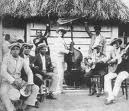9.10 Musical Groups in Cuba in the 20th Century (1900-1930).

It was in 1925 that the famous Trio Matamoros was formed in Santiago de Cuba, comprised of Rafael Cueto, Ciro Rodríguez, and Miguel Matamoros, although it is said that trios existed long before 1920. The Matamoros Trio ranks as the most famous group of its kind in Cuba. Their arrival in Havana in 1928 undoubtedly determined the fate of this Cuban musical format.
Later, other trios were founded in our country, each with its own style: those of Luisito Plá and Servando Díaz, in Santiago de Cuba; and the Cuba and Taicuba, in Havana. Around this time, Cuban female trios also emerged, such as that of the Lago Sisters, in the capital in 1932, recognized as the first female harmonic trio, with the best vocal blend of any ever heard. This already occurred in the 1930s and 1940s.
As for Cuban Son, it initially lacked a stable instrumental format; all it took was a group of people gathering together with a tres or a guitar—or both—to “form” a Son. To these instruments, the tumbadora, the botija, and the marímbula were added, indiscriminately, in which the harmonic functions of the lower register were developed.
One of the first recorded Son groups is the Cuarteto Oriental, which later, in 1920, with Havana musicians, became the Sexteto Habanero. It was precisely at that time that the musical revolution began, which would be the first major explosion in Cuban music. The creation of the Sexteto Habanero was not just an ordinary musical event; it was the founding of a sextet that paved the way for the musical genre of Son in Cuba.
Throughout its upward trajectory, the Sexteto Habanero achieved immense popularity thanks to its innovative and youthful freshness. It was the most recognized sextet of its time. These musicians paved the way for son within the aristocratic salons of the upper bourgeoisie in the early decades of the 20th century.
This musical group was the first to wear elegant suits for their performances before the Creole bourgeoisie, whom they made move to the beat of the son. Abelardo Barroso possessed a magnificent voice, and with it he crowned his singing style at this Havana gathering. Barroso, for many, is the father of son singers.
The Sexteto Habanero had its origins in the Cuarteto Oriental; and in 1927, with the addition of a trumpet, it became a septet, although people continued to call it the Sexteto Habanero. This is how this instrumental sonero format, characteristic of urban environments and of great musical influence in Cuba and the rest of the Caribbean, originated and took shape.
Another highly acclaimed group of the time was Sexteto Occidente, founded in 1926 by María Teresa Vera. This Cuban group had the opportunity to be one of the first to record in New York City. When the director of Sexteto Occidente decided to return to trova, she handed the group over to Ignacio Piñeiro, who changed its name and christened it Sexteto Nacional. Upon his death, he passed the baton to Mañungo and Rafael Ortiz, naming it Sexteto Nacional Ignacio Piñeiro as a fitting and well-deserved tribute.
The septet, as an instrumental format, seeks a more intimate communication with the listener, more discreet in terms of sound projection. Septets were the basis for formats later enriched with trumpets, congas, and piano.
Among the orchestras of the era, we must highlight the Septeto Espirituano, a Cuban group founded on June 10, 1926, in the city of Yayabo, Santi Espirituano. It is currently directed by Juan Hernández Acosta. The Septeto Espirituano’s distinctive feature is that its repertoire includes Cuban musical genres such as traditional son, bolero son, guagancó son, and afro. From its inception, this septet introduced a new variation, the so-called son capetillo. It had a slightly slower feel and was very popular in the town.
La Gloria Matancera is another prominent Cuban popular dance music group, founded on June 3, 1927, in the city of Matanzas by Juan Manuel Díaz Clemente.
The group was formed in the instrumental format of a septet. The orchestra was known only in its locality, where it became very popular, performing in every hall. With the rise of Son music in 1930, La Gloria Matancera moved to the Cuban capital.
Under the PANART label, in 1940, as a result of the resounding success achieved both in Cuba and abroad, he recorded his first album.
At that time, the septet changed its format to an ensemble, specifically in 1944, in keeping with the trends of that decade. An instrumental format consisting of piano, congas, timbalitos, double bass, two trumpets, güiro, and singers, in the 1950s, La Gloria Matancera was one of the Cuban groups most favored by the public.








